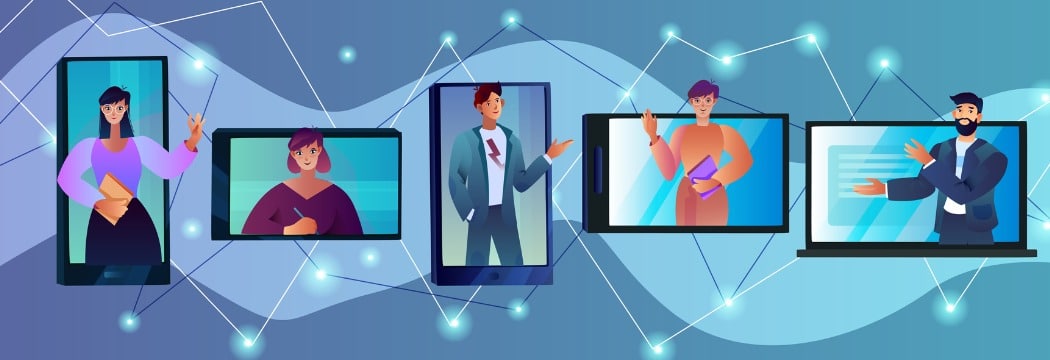Sometimes we get so caught up incorporating shiny new technologies into our workflows, we forget that rolling out new technology is the easiest part of adoption. In order for us to see the successful implementation of new technology—and the advantages it provides to our operations—there’s another part to adoption that’s much more important: culture.
As the modern workforce increasingly embraces flexible work policies, organizations are starting to rethink their communications and collaboration strategies to better accommodate remote work. Naturally, video conferencing has taken center stage. Organizations from businesses to schools and even governments have started to use video conferencing when face-to-face meetings aren’t feasible.
But while organizations have given their employees video conferencing technology, fewer than half of those employees use video regularly. When you join a meeting, chances are you see a lot of participants with their cameras turned off. That’s a problem, as more than 93% of communication comes from nonverbal cues. Also, most workplace communications still involve team messaging and emails, which can also be lackluster or misconstrued.
To get employees to fully adopt and use video as seamlessly as in-person meetings, organizations have to pursue a video-first work culture. Let’s look at key steps you can take to get there:
1. Define the goals of video in your organization
Many organizations deploy video communications technology without identifying goals, and unsurprisingly, not many employees end up using it. It’s much easier for employees to default to easier, familiar modes of communication, especially when they don’t understand what video can accomplish for them.
The first step is to spell out your organization’s goals in incorporating video into employees’ workflows. For example, if your professional services team spends half of their budget on travel, identify ways that video conferencing can help reduce travel. The team can use screen sharing for customer walkthroughs and support, saving everyone time and money.
Similarly, if your organization plans to open a new office across the country, entire departments from both offices can meet and stay connected using video conferencing. In cases like these, video is essential to team bonding and success. Once those goals have been identified, you’ll have a better idea of how to encourage your teams to embrace video.
2. Find a video conferencing solution that’s simple and versatile
In order to develop a video-first culture, video meetings have to be effortless to start. For instance, imagine that Sharon, a marketing director, wanted to start an impromptu meeting with her team to clarify a task. In order to set it up, Sharon has to send a meeting invitation to her team via email. When the team gets the meeting ID and details, they have to open a separate video meeting app just to input the details and join the meeting. By the time every member has joined, several minutes have been wasted, which makes for a poor meeting experience.
When video meetings take extra time and effort just to launch, employees simply won’t use them that often. Instead, fostering a video-first culture requires that video meetings are as easy to use as walking to a colleague’s desk and talking. User experience is king. Employees should be able to start video meetings with just the click of a button.
Consider looking for a unified solution that combines the three pillars of communication, messaging, video, and phone, in a single app. Employees can create team messaging groups for specific teams and projects and can seamlessly switch from messaging to a video meeting without having to navigate to another app. If a team needs to hop on an impromptu call to clarify a project, all it takes is going to the team messaging group and clicking a button to start a video meeting.
The easier video is to use, the more employees will embrace the technology.
3. Tout the benefits of video conferencing
Getting the entire organization on a video conferencing solution is one thing, but driving business adoption is another. Sending messages, writing emails, and making calls to coworkers are all easy and familiar. Why would employees break those habits?
Organizations need to convince employees that video is a powerful method of communication. Here are some ideas to consider implementing:
- Dedicate personnel to the task of ensuring employee adoption.
- Educate employees on how to use the technology.
- How to download and set up the video conferencing app
- Video conferencing etiquette and best practices
- How each team can benefit from video conferencing
- Promote the advantages of using video over audio and text.
- Use email campaigns to remind and encourage employees to use video.
- Hang flyers around the office to spread awareness of the new tool.
- Reward and praise teams that achieve milestones. When employees see their colleagues delivering great results, they’ll be much more likely to embrace video.
4. Lead by example: Have leaders be the champions of change
Even with a solid video conferencing solution and consistent efforts to drive awareness, change won’t completely happen unless leaders take the leap first. Employees look to their supervisors, directors, and other leaders up the ladder for guidance. That’s why it’s important that the adoption of new technologies starts from the top and funnels down.
Achieving a video-first culture requires C-level executives to be the champions of change. Start by hosting all-hands video meetings led by the CEO or CIO, with VPs and directors following suit for their own meetings. As soon as video becomes the norm for communications, employees of all levels will use it and see the benefits for themselves.
5. Incorporate rewards to further drive adoption
As with any new technology, video will take time for employees to adapt to, especially when their existing workflows are already so effective. For example, if a sales representative has been successful by calling prospects and clients for the past 20 years, there’s no incentive for him to change. Engineers might feel the same way if they simply use messaging and emails to communicate remotely.
The problem is video conferencing is quickly becoming the norm for businesses around the world, and by sticking to old methods, your organization can fall behind.
Urge employees to learn the ins and outs of video conferencing by facilitating learning and recognizing achievements. If a sales team has seen higher productivity and outcomes as a result of video conferencing, or the HR team has reduced hiring expenditures by substituting video for travel, other teams will see that success and follow suit.
Similarly, meeting facilitators can make video conferencing productive and exciting at the same time. For long periods of remote work, employees can become isolated and out of the loop, which hinders productivity in the long run. That’s why some companies use video conferencing for virtual happy hours, where departments and teams gather together on video to socialize over drinks. Companies have found other creative ways to incorporate video for remote team building too.
Prepare your organization for the workplace of the future
Whether it’s an evolving workforce or world events that accelerate the remote work trend, video can be an invaluable tool for every organization. Businesses that are equipped with the right technology and mindset will embody video-first work cultures and be fully prepared for the workplace of tomorrow.
Easy-to-use solutions like RingCentral Video will help your organization drive adoption of video conferencing. Learn more from our video below, and request a demo to try it out today.
Originally published Apr 16, 2020, updated Jan 18, 2023



